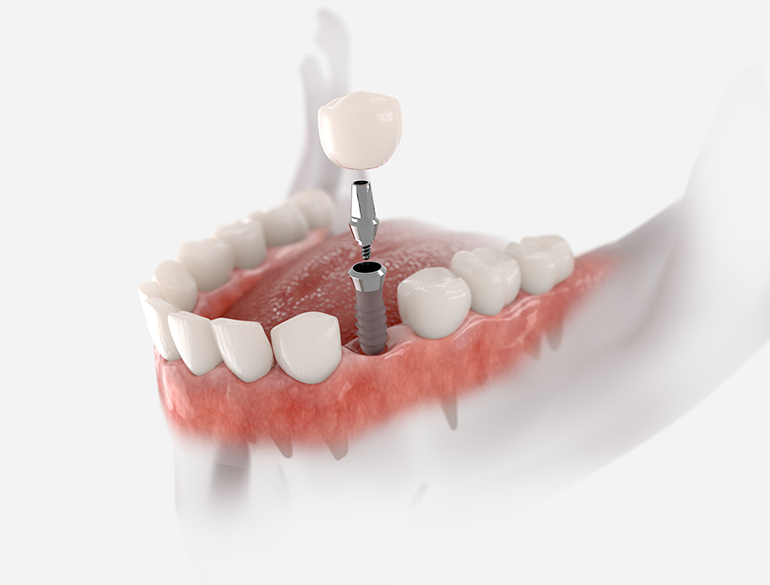The Definitive Guide for Dental Sense
The Definitive Guide for Dental Sense
Blog Article
The Best Strategy To Use For Dental Sense
Table of ContentsGetting The Dental Sense To Work9 Easy Facts About Dental Sense DescribedThe Facts About Dental Sense UncoveredDental Sense - Questions
are medical devices surgically implanted right into the jaw to recover a person's capacity to eat or their appearance. They provide assistance for synthetic (phony) teeth, such as crowns, bridges, or dentures. When a tooth is shed due to injury or condition, an individual can experience problems such as rapid bone loss, defective speech, or changes to eating patterns that lead to pain.Oral dental implant systems contain an oral implant body and oral implant abutment and might likewise consist of a joint addiction screw. Wisdom tooth cavity. The dental implant body is operatively placed in the jawbone in place of the tooth's origin. The oral implant abutment is generally connected to the dental implant body by the joint addiction screw and prolongs with gums into the mouth to support the affixed artificial teeth
(https://dentalsense1.bandcamp.com/album/dental-sense)Structure of The Dental Implant System selecting dental implants, speak to your dental supplier about the prospective benefits and risks, and whether you are a candidate for the procedure. Things to think about: Your overall wellness is an important consider determining whether you are a good prospect for dental implants, for how long it will require to heal, and just how long the dental implant might remain in place.
Cigarette smoking might impact the recovery process and lower the lasting success of the dental implant. The recovery process for the dental implant body might take numerous months or longer, throughout which time you typically have a momentary joint instead of the tooth. the oral implant treatment: Carefully comply with the oral hygiene instructions offered to you by your oral supplier.
7 Simple Techniques For Dental Sense
Implant failure can cause the need for another operation to repair or replace the dental implant system. Recovers the capacity to chew Brings back cosmetic appearance Helps keep the jawbone from shrinking because of bone loss Preserves the wellness of the surrounding bone and gums Assists keep nearby (close-by) teeth stable Improves high quality of life Damages to surrounding all-natural teeth during implant positioning Injury to the surrounding cells throughout surgery, such as sinus perforation Injury throughout surgical treatment (for instance, crack of surrounding jawbone) Poor function, such as feeling like the teeth do not bite with each other typically An experience that the tooth is loose or twisting in position arising from a joint screw loosening Implant body failure (looseness of the implant body) as a result of systemic infection, which may be more probable in patients with unrestrained diabetes mellitus due to local infection in bone and gum tissues supporting the implant body due to postponed recovery, which may be more probable in patients that smoke Trouble cleaning up the gums around the dental implant, leading to bad dental hygiene Neglected gum condition Post-surgical feeling numb due to nerve impingement or damage Constantly inform healthcare companies and imaging specialists that you have oral implants before any kind of magnetic vibration imaging (MRI) or x-ray procedures.
FDA is not familiar with any kind of damaging events reported for MRI or x-ray procedures with oral implants. Oral implants systems are generally made from materials that adhere to worldwide consensus standards of the International Company for Standardization (ISO) or ASTM International. These criteria have details of what makes a risk-free material.

An oral implant is a structure that replaces a missing out on tooth. With screw-like tools, the specialist inserts a dental implant into the jawbone, and it functions as go to the website a support for an artificial tooth, called a crown. A device called an abutment attaches the man-made tooth to the oral implant. The crown is personalized to fit the individual's mouth and match the color of their teeth.
What Does Dental Sense Mean?
Some people are not qualified for dental implant surgical procedure. It is for oral surgeons to operate people with: acute illnessuncontrollable metabolic diseasebone or soft cells illness or infectionIf these issues are resolved, an individual can have the surgical treatment. In, oral specialists avoid operating people with: If people with any one of the above undergo dental implant surgical procedure, there is a higher danger of the dental implant falling short.

Oral dental implant surgical procedure is a customized process. Give you time to recover. Attach the article and last crown, bridge or denture.
Next off, your doctor will carefully place the dental implant right into your jaw. Your doctor will reposition your periodontals and shut the incision with stitches. If your implant is near the front of your mouth, your dental professional will certainly make a momentary tooth for you to use up until you recover. By doing this, you will not have a space in your smile while you recuperate.
The Dental Sense Ideas
During the healing stage, your jawbone must fuse to the oral implant. This process can take anywhere from three to 9 months.
As soon as your implant heals, your dentist can connect the abutment (small adapter message) and your last remediation (crown, bridge or denture). This normally takes concerning one hour to complete and might call for a 2nd minor surgery. You shouldn't feel any pain during your dental implant treatment because your company will utilize drug to numb your gum tissues.
Report this page